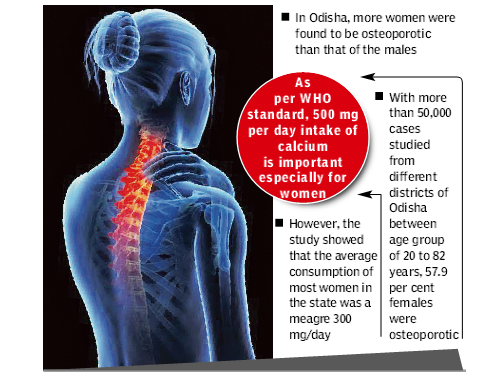Bhubaneswar: In view of rising cases of osteoporosis in Odisha, health experts here have thrown an extra word of caution for women who are more prone to the condition and have suggested for intake of more calcium-rich foods at an early stage.
Osteoporosis or extreme thinning of bones makes an individual extremely prone to debilitating and disabling fractures. According to World Health Organisation (WHO), osteoporosis is defined on the basis of bone mass measurement and is calculated comparing the peak bone mass of an individual with a young adult of the same race and sex commonly known as Bone Mineral Density (BMD).
According to recent individual studies conducted by government and private medical colleges, more women were found to be osteoporotic than that of the males. With more than 50,000 cases studied from different districts of Odisha between age group of 20 to 82 years, 57.9 per cent females were osteoporotic as against 37.9 per cent males.
“Bone mass or density is lost as we age. This happens in both men and women but it especially aggravates in women after menopause. The bones lose calcium, Vitamin D and other minerals and start losing their density. Osteoporosis-related fractures are associated with substantial pain, suffering, disability, and possibly even death for the affected patients,” explained Smarajit Pattanaik, Orthopaedic Surgeon at Apollo Hospitals.
Moreover, the studies also showed that consumption of calcium, a vital element in strengthening of bones, was found below the prescribed dosage. As per WHO standard, 500 mg/day intake of calcium is important especially for women. However, the study showed that the average consumption of most women in the state was a meagre 300 mg/day.
Citing lack of awareness, the study said that low intake was mainly found with women residing in rural, semi-urban and tribal areas of the state. “Out of 65 per cent women who had some formal education had never heard of calcium and only 30 per cent of those who had heard of it were of the opinion that milk was the only and best source of calcium,” the study stated.
Apart from age, the onset of osteoporosis is associated with a series of risk factors including poor nutrition and diet low of calcium & Vitamin D, smoking, drinking, loss of menstrual period in young women (also known as amenorrhea), genetic risk as well as body type. Women start with lower bone density than their male peers and they lose bone mass more quickly as they age, which leads to higher risk of condition amongst them.
Experts have also said that the studies are just a tip of iceberg as the cases could be much higher. While the diet patterns are more or less suggested the primary contributing factors of the condition, poor detection of osteopenia (the early hallmark of osteoporosis) in women is also said to be the main cause.
Suggesting the old adage ‘prevention is better than cure’, health experts opined that the only way to prevent osteoporosis is to start working with your bones when they are still young. While supplementing with calcium and Vitamin D remains the first line of treatment for bone loss, a new class of drugs further helps in slowing down of the natural rate at which bones break down and prevents risk of fractures.
“The achievement of peak bone mass is important to bone health, and plays a vital role in preventing osteoporosis and subsequent fractures. Peak bone mass is achieved by the age of 30. Women must therefore be very cautious about their bone health right from young age,” Pattnaik added.






































